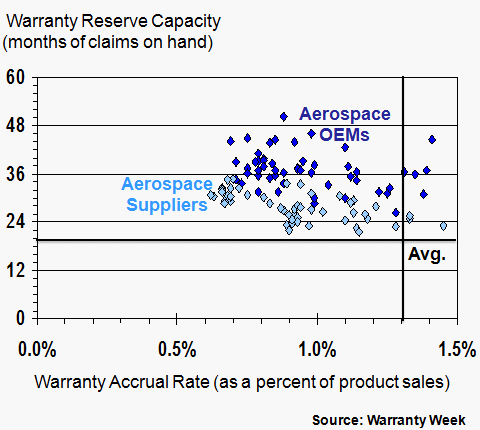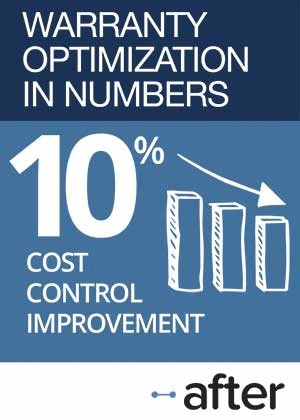Aerospace Warranty Report:Unlike the computer and automotive industries, the aerospace OEMs do not pay a vastly greater share of industry warranty expenses than do their suppliers. However, like their parts and component suppliers, they tend to provide longer warranties and keep larger reserve balances than manufacturers in other industries.
The aerospace industry is rather unique. Though the manufacturers provide warranties, failure is not an option. And though failure is not an option, they still pay out billions of dollars per year to repair or replace products under warranty. And while their warranty expense rates are generally low, their warranty reserves are generally large.
To compile the charts for this week's report on aerospace warranty expenses, we started with a list of all manufacturers of airborne vehicles, and added in a select few companies from other industries that have a significant presence in the aviation industry. These include companies such as United Technologies Corp., which we usually count in the HVAC category, and Garmin Ltd., which we usually count as a consumer electronics company, as well as AeroVironment Inc., which was part of last week's Auto Parts Supplier Warranty Report.
We ended up with a hundred companies, which we further split into ten manufacturers of airplanes, helicopters, drones, and other airborne and space-bound vehicles, and 90 companies that supplied these OEMs with parts, components and systems. United Technologies was counted as an aerospace supplier, because it sold off its helicopter division to another OEM and is now making just avionics and jet engines. Garmin also was counted as a supplier, because of its avionics product line. And AeroVironment was counted as an OEM, because it manufactures unmanned aerial vehicles for NASA and the Pentagon, among others.
U.S. Focus This Week
Boeing Co. is by far the dominant OEM on our list, primarily because most of its competitors are based outside of the U.S. We will get to those companies later in this series of weekly reports, as we will with the European and Asian passenger car makers and other non-U.S.-based manufacturers. This week is for just the U.S. companies and the U.S. companies that base themselves elsewhere for tax reasons.
But there are a few other large U.S.-based aerospace OEMs such as Textron Inc., owners of Bell Helicopter, and General Dynamics Corp., makers of the Gulfstream family of business jets. And then there are a few satellite manufacturers, and some military jet manufacturers (who mostly don't report their warranty expenses).
The supplier list is meanwhile dominated by United Technologies. But there are numerous other large warranty providers on the list, such as B/E Aerospace Inc.; FMC Technologies Inc.; Honeywell International Inc.; L-3 Communications Corp.; and Rockwell Collins Inc.
In Figure 1, we've added up all their warranty claims payments for the past 13 years. For the past four years, the OEMs and suppliers have split the payments close to 50/50, though from 2004 to 2009 the suppliers paid close to 70% of the bill. This is precisely the opposite of the pattern seen in the automotive and computer industries, where the customer-facing OEMs usually pay the most and pay the highest rates.
Figure 1
Aerospace Warranties
Claims Paid Worldwide by U.S.-based Manufacturers
(in US$ millions, 2003-2015)
Notice also that claims payments are generally declining. The peak year remains 2008 for both the suppliers and for the industry overall. Notice that the suppliers paid out more than a billion dollars in each of the six years from 2006 to 2011, but haven't done so in the four years since. It's not because sales have fallen. It's because warranty costs have been cut even as sales increased.
For the OEMs, the peak year remains 2014, when Boeing ran into trouble with its 787 Dreamliner, and Textron also saw a spike. But both of them saw claims payments fall in 2015, which led to a 16% decline in the OEM claims total. For them, as with the top passenger car makers, 2015 was a year of recovery -- of getting back to normal.
But some companies did see their claims bill soar in 2015. General Dynamics increased its claims payments from $78 million to $120 million. B/E Aerospace increased its claims payments from $34 to $42 million. Standex International Corp. more than tripled its claims cost to $14.4 million. And Ametek Inc. saw its claims cost soar from $12 to $20 million.
Warranty Accruals
On the accrual side, the patterns were a little different. For this warranty metric, 2014 remains the peak year. In fact, it's the only year in which both the aerospace OEMs and suppliers each set aside more than a billion dollars in accruals. In every other year, one or both groups has been below a billion dollars.
Last year, they both were, with overall accruals down 15%, led by a massive $235 million decline by the OEMs. And that, in turn, was led by a $145 million decline in accruals just for Boeing.
Figure 2
Aerospace Warranties
Accruals Made Worldwide by U.S.-based Manufacturers
(in US$ millions, 2003-2015)
During the years 2012 to 2014, the OEMs actually accrued more than the suppliers. This is in keeping with the pattern seen in other industries, but it's completely out of character with the rest of the aerospace industry warranty metrics.
Again, the reason was Boeing, which radically raised its accruals in those years before turning back down its accruals in 2015. Meanwhile, B/E Aerospace and Standex International radically increased their accrual totals in 2015. Ametek and FLIR Systems Inc. raised their accruals appreciably. And L-3 Communications raised its accruals total slightly.
On the downside, Honeywell, Rockwell Collins, and United Technologies reduced their accruals noticeably. But none of their accrual reductions were big enough to warranty a mention in any of the top 10 lists in the March 17 newsletter. Only General Dynamics and B/E Aerospace on the upside, and Boeing on the downside, made any of those lists.
The thing is, claims and accruals also rise and fall for reasons other than problems with recalls or product quality. For instance, Textron acquired the Beechcraft Corp. in early 2014 and added $67 million to its warranty reserves as a result. OSI Systems Inc. and FMC Technologies Inc. are adjusting their warranty expenses to reflect lower sales volumes. Both Boeing and United Technologies began removing excess reserves after concluding they had over-accrued in 2014 and 2015.
Warranty Expense Rates
A clearer picture emerges when claims and accruals are compared to product sales, to calculate warranty expense rates. In Figures 3 and 4, we've taken the raw claims and accrual data from Figures 1 and 2 and compared them to product sales.
It's immediately clear in Figure 3 why the accrual levels for the aerospace OEMs were so high from 2012 to 2014. It was because the OEMs -- specifically Boeing -- were setting aside a much higher-than-normal percentage of their product sales as warranty accruals.
Figure 3
Aerospace OEMs
Average Warranty Claims & Accrual Rates
(as a % of product sales, 2003-2015)
As was mentioned, 2015 was more about getting back to normal, and indeed the OEMs' warranty expense rates last year were more in keeping with the 2005-to-2011 baseline. In fact, their warranty claims rate hit a low of 0.8% at the end of 2015 that they last saw in 2007, while their warranty accrual rate at 0.9% was back to mid-2011 levels.
However, nobody would look at the shape of Figure 3 and think that the OEMs have made much progress in their efforts to control their warranty costs. instead, it looks like they had a pair of bad years followed by seven good years, three bad years, and finally one more good year.
In contrast, the average expense rates of the 90 aerospace suppliers tracked in Figure 4 show an unmistakable downward trend from at least 2003 to 2014. It looks like 2015 represents a bit of an upturn, but that's from the record low expense rates below 0.7% seen in 2013 and 2014.
Figure 4
Aerospace Suppliers
Average Warranty Claims & Accrual Rates
(as a % of product sales, 2003-2015)
Rockwell Collins was one of the few aerospace suppliers to reduce both its claims and accrual rates last year. More common was a pattern where one rate slightly fell while the other slightly rose, as was seen with Honeywell, Garmin, and United Technologies. But some, such as Ametek, FMC Technologies, and FLIR Systems, saw both of their expense rates rise significantly. So it's no surprise that the average expense rates rose slightly in 2015.
Warranty Reserves
Our next metric is the closing balance in the warranty reserve funds of these 100 aerospace companies. As can be seen in Figure 5, it has generally risen over the past decade. But it fell in 2015, as it did from 2007 to 2009. Granted, the decline in reserves last year was a relatively small (-3%) decline. But it was the first decline since the last recession.
Figure 5
Aerospace Warranties
Reserves Held Worldwide by U.S.-based Manufacturers
(in US$ millions, 2003-2015)
This time, we can't blame Boeing. Its warranty reserve balance declined by only one percent in 2015. Instead, it was United Technologies that allowed its warranty reserves to contract by more than $100 million, and several others that reduced their reserves by smaller amounts.
Warranty Reserve Capacity
A better way to measure warranty reserves might be to compare the balance to claims cost. Imagine a company has a $12 million warranty reserve balance and is paying $12 million a year in claims. That's equal to $1 million a month, and that would make its reserves large enough to pay claims for 12 months.
Now, imagine that claims payments drop to $500,000 a month, and the reserves balance rises to $15 million. That would be equal to 30 months, which might turn out to be an excessively high multiple if the company's product warranties last for only one year.
However, in the aerospace industry, one year is a short amount of time. Warranties usually last multiple years, even on supplier parts and components. Furthermore, there is a safety-driven effort to replace parts before they fail during use, and an incredible amount of paperwork and testing that goes into determining when a part should be replaced. Extended warranties, in fact, are more about guarantees of performance metrics such as fuel consumption than they are about break/fix coverage.
So the warranties are generally long, and the tendency to replace components before they fail very strong. In addition, in the case of commercial airlines, the customer is performing most of the labor. And they're sharing spare parts amongst each other in strategically determined locations, to help make sure that very few airplanes are ever stuck on the ground.
Across the entire manufacturing spectrum, all warranty-providing companies keep an average of 19 months of claims in their warranty reserves. But in the aerospace industry, even the suppliers tend to keep an average of no less than 28 months' worth of reserves on hand at all times. And in the past 52 quarters, they've allowed that ratio to drop below 24 months only seven times, and never since midway through 2009.
In Figure 6, we're plotting a chart of the average ratios between claims and reserves, measured in months, for both the aerospace OEMs and their suppliers. And we're also plotting the average accrual rates of the two groups, using the same accrual rate data as was in Figures 3 and 4.
At the end of 2015, the average accrual rate for all manufacturers was 1.3%. Most aerospace manufacturers are well below that. However, also notice that they're almost always above average in terms of their claims-to-reserves ratios.
Figure 6
Warranty Reserves vs. Accruals
Aerospace OEMs vs. Suppliers
(in months of claims & % of sales, 2003-2015)
There are 104 data points on the chart above, and they range from 21.5 months to an astronomical 50 months. But while most of the lower data points represent the suppliers, all of the highest points represent the OEMs. In other words, the OEMs tend to keep a much higher ratio between claims and reserves, sometimes exceeding four years.
Again, it looks like Boeing is to blame. At the end of 2015 it had a warranty reserve of $1.485 billion. But at the time, its claims payments were falling fast, hitting a low of only $20.3 million per month in the fourth quarter of last year. Therefore, its reserve balance was equal to 73 months of capacity at the end of 2015, up from 47 months at the end of 2014.
Not Fixing Warranty Reserve Levels?
United Technologies was in a similar situation. As was mentioned, it took $100 million out of its warranty reserve last year. But its claims payments fell faster, from $344 million in 2014 to $259 million in 2015. So its claims-to-reserves ratio rose from a high 45 months to a very high 87 months. Clearly, when it sold Sikorsky Aircraft to Lockheed Martin, it didn't readjust its reserves balance to compensate.
Others with hefty warranty reserve cushions at the end of last year included General Dynamics (50 months), B/E Aerospace (29 months), and Rockwell Collins (26 months). But these companies have more or less always maintained a high ratio between claims and reserves. And that's the reason why in Figure 6 their average warranty reserve capacity is always higher than the general manufacturing average, despite their usually lower-than-average warranty accrual rates.
| 













